
Juniperus virginiana, known as red cedar, eastern redcedar, Virginian juniper, eastern juniper, red juniper, pencil cedar, and aromatic cedar, is a species of juniper native to eastern North America from southeastern Canada to the Gulf of Mexico and east of the Great Plains. Further west it is replaced by the related Juniperus scopulorum and to the southwest by Juniperus ashei.

Helianthus is a genus comprising about 70 species of annual and perennial flowering plants in the daisy family Asteraceae. Except for three South American species, the species of Helianthus are native to North America and Central America. The common names "sunflower" and "common sunflower" typically refer to the popular annual species Helianthus annuus, whose round flower heads in combination with the ligules look like the sun. This and other species, notably Jerusalem artichoke, are cultivated in temperate regions and some tropical regions as food crops for humans, cattle, and poultry, and as ornamental plants. The species H. annuus typically grows during the summer and into early fall, with the peak growth season being mid-summer.

Lithospermum is a genus of plants belonging to the family Boraginaceae. The genus is distributed nearly worldwide, but most are native to the Americas and the center of diversity is in the southwestern United States and Mexico. Species are known generally as gromwells or stoneseeds.
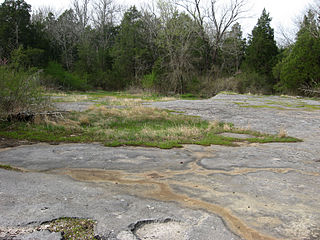
A calcareous glade is a type of ecological community that is found in the central eastern United States. Calcareous glades occur where bedrock such as limestone occurs near or at the surface, and have very shallow and little soil development. Because of the shallow soil and the extreme conditions created by it, trees are often unable to grow in the glades. This creates a habitat that is usually sunny, dry, and hot. Calcareous glade vegetation is more similar to that of a desert habitat than a grassland, being dominated by small spring annuals with occasional geophytic or succulent perennials.

The Appalachian mixed mesophytic forests is an ecoregion of the temperate broadleaf and mixed forests biome, as defined by the World Wildlife Fund. It consists of mesophytic plants west of the Appalachian Mountains in the Southeastern United States.

The central U.S. hardwood forests comprise a temperate broadleaf and mixed forests ecoregion in the Eastern United States, as defined by the World Wildlife Fund. It has one of the most diverse herbaceous plant floras of ecoregions in North America.

Lithospermum canescens, or the hoary puccoon is a perennial herb endemic to eastern North America. The plant has golden yellow flowers which bloom from April to May.
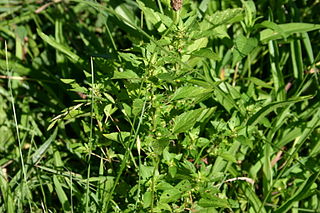
Acalypha rhomboidea is a plant in the spurge family, Euphorbiaceae.
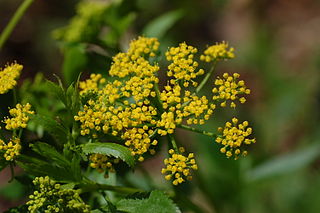
Zizia aurea is a flowering perennial forb of the carrot family (Apiaceae). Golden alexanders is native to eastern Canada and the United States, from the eastern Great Plains to the Atlantic Coast. Named for Johann Baptist Ziz. a German botanist.

Liatris cylindracea is a plant species in the aster family. It is native to eastern North America, where its populations are concentrated in the Midwestern United States. It is found in habitats such as prairies, limestone and sandstone outcroppings, bluffs, barrens, glades, woodlands and dunes.

The Interior Low Plateaus are a physiographic region in eastern United States. It consists of a diverse landscape that extends from north Alabama across central Tennessee and Kentucky into southern Illinois, Indiana, and Ohio. Its natural communities are a matrix of temperate forests, woodlands, and prairies.
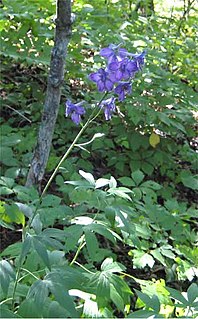
Delphinium exaltatum is a species of flowering plant in the buttercup family known by the common name tall larkspur. Other Delphinium species may be called tall larkspur, such as Delphinium barbeyi. D. exaltatum is native to the central and eastern United States, where it can be found in Kentucky, Maine, Ohio, Pennsylvania, Maryland, West Virginia, Virginia, North Carolina, Alabama, Tennessee, and Missouri.

Sericocarpus linifolius is a perennial forb native to the eastern United States, that produces white composite flowers in summer.
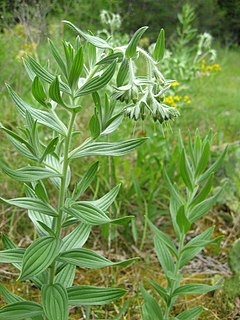
Lithospermum molle, the softhair marbleseed, is a species of flowering plant in the forget-me-not family. This species is a narrow endemic, native primarily to the Nashville Basin of Tennessee, where it is found in limestone prairies near cedar glades. There are disjunct populations in similar habitats in the Ozark Mountains of Missouri, in northwest Alabama, in Logan and Warren County, Kentucky as well as other small areas of Tennessee. Outside of Tennessee, it is very rare and perhaps no longer exists in Alabama and Kentucky due to habitat destruction. Because of its highly restricted geographic range, this species is considered vulnerable.

Lithospermum tuberosum, commonly called the southern stoneseed or tuberous stoneseed, is a species of flowering plant in the forget-me-not family. It is native to the Southeastern United States, where it is found in calcareous woodlands.
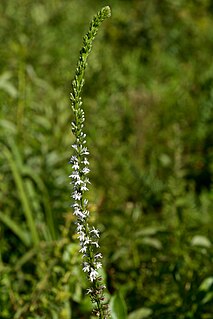
Lobelia spicata, commonly called the pale spiked lobelia, is a flowering plant in the bellflower family.

Asclepias hirtella, commonly called the tall green milkweed, is a species of flowering plant in the dogbane family (Apocynaceae). It is native to Canada and the United States, where its range is concentrated in the Midwest and Upper South.

Viola sagittata, commonly called the arrowleaf violet, is a species of flowering plant in the violet family (Violaceae). It is native to the eastern North America in Canada and the United States, where it is widespread. It is found in a variety of natural habitats, but is most common in dry, open communities such as prairies, glades, or woodlands, often in sandy or rocky soil.
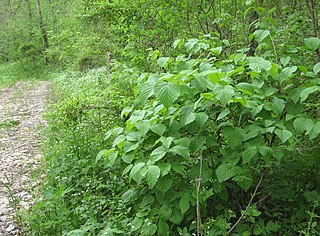
Viburnum molle, commonly called softleaf arrowwood, is a species of flowering plant in the moschatel family (Adoxaceae). It is native to the eastern United States, where it restricted to the Midwest and Upper South. Its distribution is scattered, and populations occur in disjunct clusters. Its natural habitat is in rocky bluff forests over calcareous soil, and in adjacent bottomlands.
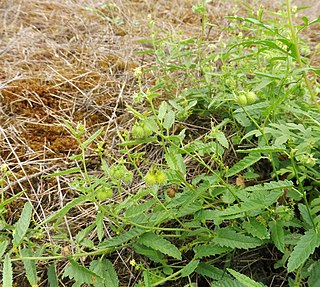
Tragia betonicifolia, commonly called betonyleaf noseburn, is a species of flowering plant in the spurge family (Euphorbiaceae). It is native to North America, where it is primarily found in the South-Central region of the United States extending north into Kansas and Missouri, with disjunct populations east in Tennessee. Its typical natural habitat is dry areas with sandy or rocky soil, in glades, prairies, bluffs, and dry woodlands.



















